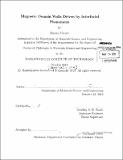Magnetic domain walls driven by interfacial phenomena
Author(s)
Emori, Satoru
DownloadFull printable version (29.03Mb)
Other Contributors
Massachusetts Institute of Technology. Department of Materials Science and Engineering.
Advisor
Geoffrey S. D. Beach.
Terms of use
Metadata
Show full item recordAbstract
A domain wall in a ferromagnetic material is a boundary between differently magnetized regions, and its motion provides a convenient scheme to control the magnetization state of the material. Domain walls can be confined and moved along nanostrips of magnetic thin films, which are proposed platforms for next generations of solid-state magnetic memory-storage and logic devices. In these devices, domain walls must be moved by electric current, rather than by magnetic field, to achieve scalability and lower-power operation. Recent studies have reported efficient domain-wall motion driven by current in out-of-plane magnetized multilayer films with strong spin-orbit coupling. In particular, extraordinary current-driven domain-wall motion has been observed in atomically-thin ferromagnets sandwiched between a nonmagnetic heavy metal and an insulator. Through experimental studies on various sputtered magnetic multilayers, we elucidate the mechanism of such anomalous domain-wall dynamics. We show that conventional current-induced spin-transfer torques, which drive domain walls in thicker films, are negligible in ultrathin ferromagnets. We also show that the Rashba field, often reported in materials with strong spin-orbit coupling, does not contribute to the observed efficient domain-wall motion. The anomalous dynamics instead emerges from the spin Hall effect: a charge current in the nonmagnetic heavy metal generates a spin current, which exerts a torque on spins in the adjacent ferromagnet. This spin Hall torque drives domain walls forward if the domain-wall spins are parallel to the nanostrip axis with a fixed chirality. We reveal that the Dzyaloshinskii-Moriya interaction, arising from spin-orbit coupling and asymmetric interfaces, stabilizes homochiral domain walls in ultrathin ferromagnets. Our findings not only provide a route to bolster current-driven domain-wall dynamics, but also enable new chiral magnetic textures in magnetic heterostructures for device applications.
Description
Thesis: Ph. D., Massachusetts Institute of Technology, Department of Materials Science and Engineering, February 2014. Cataloged from PDF version of thesis. "October 2013." Includes bibliographical references.
Date issued
2014Department
Massachusetts Institute of Technology. Department of Materials Science and EngineeringPublisher
Massachusetts Institute of Technology
Keywords
Materials Science and Engineering.